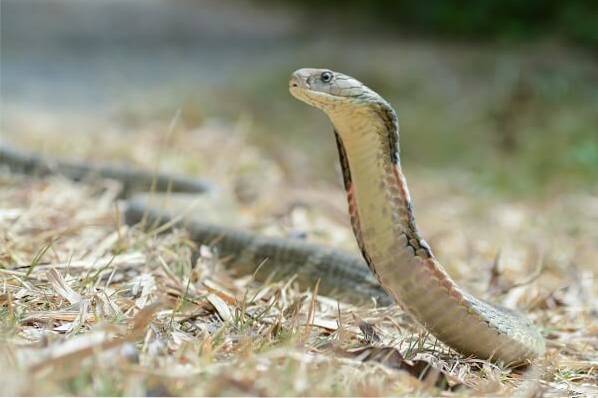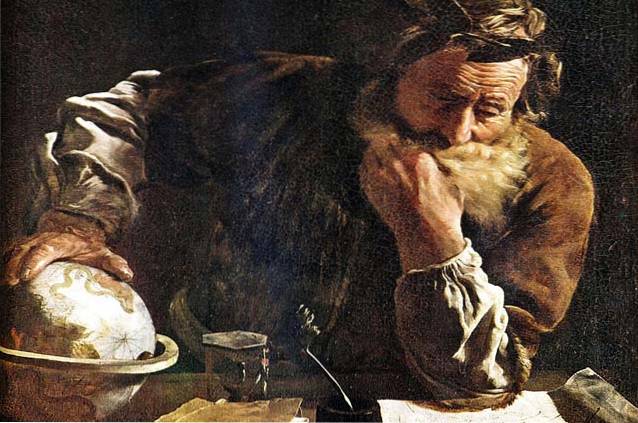
King Cobra characteristics, habitat, bite, behavior
The King Cobra (Ophiophagus hannah) is the longest venomous snake in the world. As an adult, this snake can measure up to 5.85 meters. It is an endemic species of India, which spans various regions of Southeast Asia.
Its body is covered with scales, which in the dorsal region are arranged obliquely. In terms of coloration, the king cobra is brown or olive green, with black, yellow or white transverse stripes. The hoods are olive green, with a black spot, which characterizes the species.

Ophiophagus hannah it uses the poison to defend itself from its predators and to capture its prey. The toxins mainly affect the nervous and muscular systems. Thus, they block nerve transmission receptors, resulting in death due to respiratory and cardiac failure..
The king cobra is in danger of extinction, mainly due to the loss of its habitat and its poaching. It is also marketed internationally as a pet..
Article index
- 1 Features
- 1.1 - Skin
- 1.2 - Head
- 1.3 - Size
- 1.4 - Poison
- 1.5 - Defense
- 2 Habitat and distribution
- 3 Taxonomy
- 4 State of conservation
- 4.1 Threats
- 4.2 Conservation actions
- 5 Food
- 6 Playback
- 7 Sting
- 7.1 Symptoms
- 7.2 Treatment
- 8 Behavior
- 9 References
Characteristics
- Skin
The skin of the king cobra is covered in scales. Those found on the body are smooth and obliquely arranged and the ventral scales have an oval shape..
On the head are 15 scutes and on the upper part it has a pair of large occipital scales. In the neck there are between 17 and 19 rows and in the middle of the body there are 15 rows of scales, plus two larger lateral ones. In relation to the belly, it has 240 to 254 rows of shields and the underflows add up to a total of 84 to 104.
Coloration
The youngsters are jet black. The body and tail have chevron-shaped lines or white, directed towards the head. In the head it has four transverse bars, similar to those of the body.
When the king cobra becomes an adult, it takes on shades of brown or olive green. It usually has white, yellowish or black transverse bands. The belly can be uniformly single-colored or adorned with bars. In relation to the tail, it is cylindrical and marked in black.
- Head
The head of the Ophiophagus hannah it is voluminous in appearance and hardly differs from the neck. The muzzle is rounded and the tongue is black. Regarding the mandible, the maxillary bone is extended forward, well beyond the palatine.
Likewise, these bone structures can expand, to facilitate the animal ingesting large prey. This species has a proteroglyph dentition, where the two fangs that inoculate the venom are short and are fixed in the front area of the mouth..
After these teeth, the upper jaw has three to five small mouthparts. In the lower one it has two rows of teeth.
In relation to the nostrils, they are large and are located between two nasal scales. The eyes have golden irises and the pupils are rounded..
The distinctive hood of the king cobra is oval and the shields that cover it are smooth. It has an olive green color, with two black spots.
- Size
The king cobra is sexually dimorphic, with the male being larger than the female. Thus, it measures approximately 3.75 meters and its weight is 10 kilograms. As for the female, it is 2.75 meters long, with a body mass of up to 5 kilograms..
- Poison
This species has venom glands where the toxic substance is synthesized, as well as an injection mechanism. Its fangs are short and modified to inoculate the venom to the prey or to the animal that threatens it.
In relation to the glands, they are a modification of the salivary gland and are located behind the eyes, wrapped in a muscle-type capsule. In these structures there are large alveoli, where the toxic substance is stored.
The poison of the Ophiophagus hannah It is made up of neurotoxins and cytotoxins. Toxic compounds are primarily polypeptides and proteins. Among this group are phospholipases, muscarinic toxin, proteases and L-amino acid oxidase..
Also, it contains sodium, potassium, calcium and magnesium and small portions of zinc, cobalt, iron, nickel and manganese. The venom of the king cobra is the least toxic of the group of poisonous snakes.
However, in one bite, this snake can inject large amounts of this toxic substance, around 7 milliliters, enough to kill an elephant in less than three hours.
- Defending
Despite its appearance, this snake prefers to escape when disturbed. However, the female fiercely defends her eggs, being able to attack the predator quickly and violently..
When threatened, it raises the front of its body, spreads its hood, shows its fangs, and whistles. This sound is below 2,500 Hz, while in the rest of the snakes it could reach up to 13,000 Hz..
When in a threatening display, the Ophiophagus hannah It can raise the front region to one meter above the ground. In this position, he is able to pursue the enemy, giving him numerous bites in a single attack..
Habitat and distribution
Ophiophagus hannah it is widely distributed to Southeast and South Asia. Thus, it is found from Terai in India, southern Nepal, Myanmar, Bangladesh and the Brahmaputra river basin in Bhutan. It also lives in southern China, Thailand, Cambodia, Laos, Malaysia, Vietnam, Singapore, the Philippines, and Indonesia..
In relation to the northern region of India, it occurs in the Garhwal Himalayas, Uttarakhand, Sikkim and in Uttar Pradesh. In the Eastern Ghats, it is located from the coastal area of Odisha to Andhra Pradesh. As for the Western Ghats, it is recorded in Kerala, Maharashtra, and Karnataka and Kerala. Also, he lives on Baratang Island.
The king cobra is found in a great diversity of habitats, mainly virgin forests, although it can be present in degraded forests, open or dense forests, mangroves, bushes and even in agricultural areas, such as palm oil and tea plantations..
Also, this species has been sighted in dry grasslands located at high altitudes. Experts point out that it tends to occur in low population density, since the individual household range is approximately 6.3 km2.
Taxonomy
-Animal Kingdom.
-Subkingdom: Bilateria.
-Phylum: Chordate.
-Subfium: Vertebrate.
-Infrafilum: Gnathostomata.
-Superclass: Tetrapoda.
-Class: Reptilia.
-Order: Squamata.
-Suborder: Serpentes.
-Infraorder: Alethinophidia.
-Family: Elapidae.
-Subfamily: Elapinae.
-Genus: Ophiophagus.
-Species: Ophiophagus hannah.
State of conservation
King cobra populations are threatened by various factors, which cause their decline. This situation has caused the IUCN to categorize this species as vulnerable to extinction..
Threats
One of the main problems that afflicts this snake is the destruction of its natural habitat. Currently, Southeast Asia has one of the highest rates of deforestation, taking into account the rest of the tropical regions.
This has forced these snakes to move to degraded areas, where there is no certainty that they can develop in a viable way. In this sense, in Chitwan, Nepal, the vast majority of youth communities are on agricultural land, always close to the forest. However, these areas can be taken as feeding places.
Another factor that puts populations at risk is hunting. This species is captured to market its skin and meat, with which exotic dishes are made. Also, it is sold as a pet, with Malaysia and Indonesia being the main exporters..
The king cobra is widely used in traditional medicine, especially in China, Laos, Vietnam, Cambodia, and Myanmar. On the other hand, because it is the largest poisonous snake in the world, it is hunted and captured by the locals, as it is considered a danger to them..
Conservation actions
The Ophiophagus hannah it is listed in Appendix II of CITES. However, the researchers suggest increasing conservation measures in order to reduce the rate of habitat destruction and to more effectively control the trade of this species..
In addition, it is necessary to investigate and monitor the state of the populations. On the other hand, there are viable proposals related to the implementation of educational programs. These are oriented towards reducing the persecution and death of the animal.
In Royal Chitwan National Park, a new project is underway. Its main objective is the correct management of information on large reptiles and the ecological monitoring of the king cobra..
Feeding
The king cobra mainly feeds on other snakes, such as the Asian rat snake, the green whip snake, and pythons up to 10 meters long. Also, you can hunt the hump-nosed viper and the Malabar viper, following the scent trail they leave behind..
It does not usually consume poisonous species, but there is evidence that it has hunted Indian kraits and cobras. Some king cobras have diets restricted to a single species of snake, rejecting any other type of animal.
When food is no longer abundant, they usually include other small-sized vertebrates in their diet, such as birds, lizards, and rodents..
The Ophiophagus hannah It cannot chew its prey, so it swallows it whole, starting at the head. This is possible because the jaws are attached to each other by elastic ligaments, allowing your mouth to open widely..
In relation to the digestive process, this is carried out due to the action of acids that are produced in the stomach and the enzymes contained in saliva.
Reproduction
This species is oviparous and is sexually mature when it is between 5 and 6 years old. Generally, mating occurs from January to April, the eggs are hatched in the spring and the young hatch in the fall..
The female is in charge of building the nest, which can measure up to 55 centimeters high, in the central area, and 140 centimeters wide. To build it, he gathers dry leaves and places them at the base of a tree..
During copulation, the male introduces one of his two hemipenis into the female's cloaca and releases the sperm. Once the eggs are fertilized, the female takes between 50 and 59 days to deposit the eggs.
The laying can vary between 7 and 40 eggs, which hatch after 66 to 105 days. During incubation, the mother remains in the nest, while the male stays close to it, to defend the eggs from predators..
As for the young, they measure from 37.5 to 58.5 centimeters in length and weigh between 9 and 38 grams. The venom of these is as powerful as that of adults.
Bite
Symptoms
The symptoms of poisoning from the bite of a king cobra can be determined by the amount of venom inoculated, the site of the wound, the size of the person, age and health status..
The toxins in the poison mainly affect the central nervous system. This causes severe pain, vertigo, blurred vision, drowsiness, and paralysis..
Locally, there is a severe burning in the area of the bite, which quickly becomes inflamed. Then, it begins to exude the blood serum. After 15 to 120 minutes, seizures begin to occur.
If the poisoning is severe, or is not treated in time, cardiovascular collapse ensues and the victim falls into a coma. Death can occur within 30 minutes of being bitten by the snake, due to respiratory failure.
Treatment
King cobra sting poisoning is a medical emergency and requires immediate medical attention..
While the person is taken to the nearest medical center, specialists recommend stripping the person of rings or any other jewelery. This is because, if the limb becomes inflamed, these accessories can act as tourniquets..
In the event that the wound is in one of the extremities, a wide bandage can be placed, exerting moderate pressure, so that circulation is not affected. Likewise, the limb must be immobilized, since the muscular contraction promotes the absorption of the poison..
Behaviour
The king cobra has diurnal habits, being able to hunt at any time of the day. To locate its prey, this snake receives chemical information from the environment through its forked tongue, which is in constant motion. This captures the odor particles and transfers them to the Jacobson's organ.
This structure is located on the palate and functions as a sensory receptor. Stimuli, coming from the air, water or soil, are processed by the brain, thus obtaining precise information on the presence of prey, predators or sexual partners.
To capture its prey, this species also uses its keen sense of sight. They have the ability to detect an animal in motion, even if it is 100 meters away.
References
- Wikipedia (2019). King charges. Recovered from en.wikipedia.org.
- The reptile database (2019). Ophiophagus hannah (SINGER, 1836). Recovered from reptile-database.reptarium.cz.
- Young, D. (1999). Ophiophagus Hannah. Animal Diversity Web. Recovered from animaldiversity.org.
- Stuart, B., Wogan, G., Grismer, L., Auliya, M., Inger, RF, Lilley, R., Chan-Ard, T., Thy, N., Nguyen, TQ, Srinivasulu, C., Jelić, D. (2012). Ophiophagus Hannah. The IUCN Red List of Threatened Species 2012. Recovered from iucnredlist.org.
- K. Gupta (2016). Poisons of animal origin. Recovered from sciencedirect.com.
- ITIS (2019). Ophiophagus Hannah. Recovered from it is.gov.
- Clinical toxicology results (2019). Ophiophagus Hannah. Recovered from toxinology.com.
- Danpaiboon, W, Reamtong, O., Sookrung, N., Seesuay, W., Sakolvaree, Y., Thanongsaksrikul, J., Dong-din-on, F., Srimanote, P., Thueng-in, K .; , Chaicumpa, W. (2014). Ophiophagus hannah Venom: Proteome, Components Bound by Naja kaouthia Antivenin and Neutralization by N. kaouthia Neurotoxin-Specific Human ScFv. Toxins 2014, 6, 1526-1558. Recovered from mdpi.com.



Yet No Comments